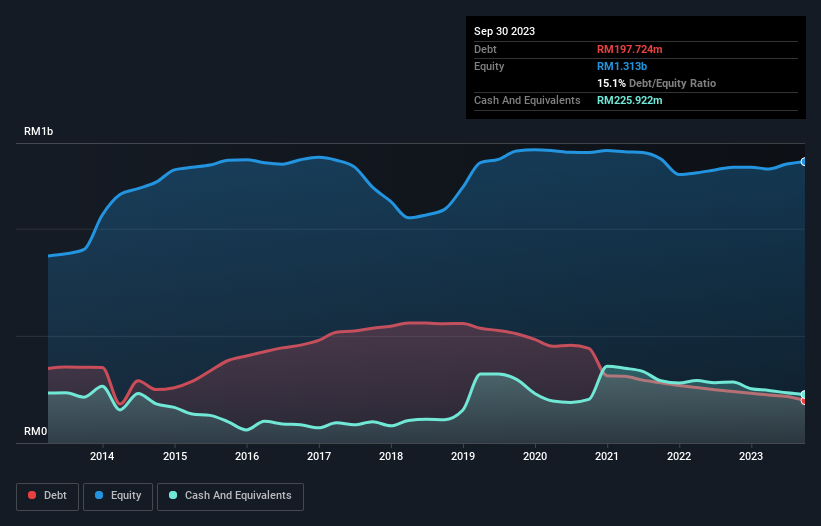Some say volatility, rather than debt, is the best way to think about risk as an investor, but Warren Buffett famously said that 'Volatility is far from synonymous with risk.' It's only natural to consider a company's balance sheet when you examine how risky it is, since debt is often involved when a business collapses. We can see that Naim Holdings Berhad (KLSE:NAIM) does use debt in its business. But the more important question is: how much risk is that debt creating?
What Risk Does Debt Bring?
Debt assists a business until the business has trouble paying it off, either with new capital or with free cash flow. Ultimately, if the company can't fulfill its legal obligations to repay debt, shareholders could walk away with nothing. However, a more frequent (but still costly) occurrence is where a company must issue shares at bargain-basement prices, permanently diluting shareholders, just to shore up its balance sheet. Having said that, the most common situation is where a company manages its debt reasonably well - and to its own advantage. The first step when considering a company's debt levels is to consider its cash and debt together.
Check out our latest analysis for Naim Holdings Berhad
What Is Naim Holdings Berhad's Debt?
As you can see below, Naim Holdings Berhad had RM197.7m of debt at September 2023, down from RM240.5m a year prior. But on the other hand it also has RM225.9m in cash, leading to a RM28.2m net cash position.

How Strong Is Naim Holdings Berhad's Balance Sheet?
According to the last reported balance sheet, Naim Holdings Berhad had liabilities of RM439.8m due within 12 months, and liabilities of RM92.4m due beyond 12 months. On the other hand, it had cash of RM225.9m and RM196.1m worth of receivables due within a year. So its liabilities outweigh the sum of its cash and (near-term) receivables by RM110.1m.
While this might seem like a lot, it is not so bad since Naim Holdings Berhad has a market capitalization of RM450.7m, and so it could probably strengthen its balance sheet by raising capital if it needed to. But we definitely want to keep our eyes open to indications that its debt is bringing too much risk. While it does have liabilities worth noting, Naim Holdings Berhad also has more cash than debt, so we're pretty confident it can manage its debt safely. When analysing debt levels, the balance sheet is the obvious place to start. But you can't view debt in total isolation; since Naim Holdings Berhad will need earnings to service that debt. So if you're keen to discover more about its earnings, it might be worth checking out this graph of its long term earnings trend.
Over 12 months, Naim Holdings Berhad made a loss at the EBIT level, and saw its revenue drop to RM371m, which is a fall of 19%. We would much prefer see growth.
So How Risky Is Naim Holdings Berhad?
While Naim Holdings Berhad lost money on an earnings before interest and tax (EBIT) level, it actually booked a paper profit of RM22m. So taking that on face value, and considering the cash, we don't think its very risky in the near term. With revenue growth uninspiring, we'd really need to see some positive EBIT before mustering much enthusiasm for this business. When analysing debt levels, the balance sheet is the obvious place to start. But ultimately, every company can contain risks that exist outside of the balance sheet. For example - Naim Holdings Berhad has 1 warning sign we think you should be aware of.
When all is said and done, sometimes its easier to focus on companies that don't even need debt. Readers can access a list of growth stocks with zero net debt 100% free, right now.
Valuation is complex, but we're here to simplify it.
Discover if Naim Holdings Berhad might be undervalued or overvalued with our detailed analysis, featuring fair value estimates, potential risks, dividends, insider trades, and its financial condition.
Access Free AnalysisHave feedback on this article? Concerned about the content? Get in touch with us directly. Alternatively, email editorial-team (at) simplywallst.com.
This article by Simply Wall St is general in nature. We provide commentary based on historical data and analyst forecasts only using an unbiased methodology and our articles are not intended to be financial advice. It does not constitute a recommendation to buy or sell any stock, and does not take account of your objectives, or your financial situation. We aim to bring you long-term focused analysis driven by fundamental data. Note that our analysis may not factor in the latest price-sensitive company announcements or qualitative material. Simply Wall St has no position in any stocks mentioned.
About KLSE:NAIM
Naim Holdings Berhad
An investment holding company, engages in the property development and construction businesses in Malaysia.
Flawless balance sheet with solid track record.
Market Insights
Community Narratives




